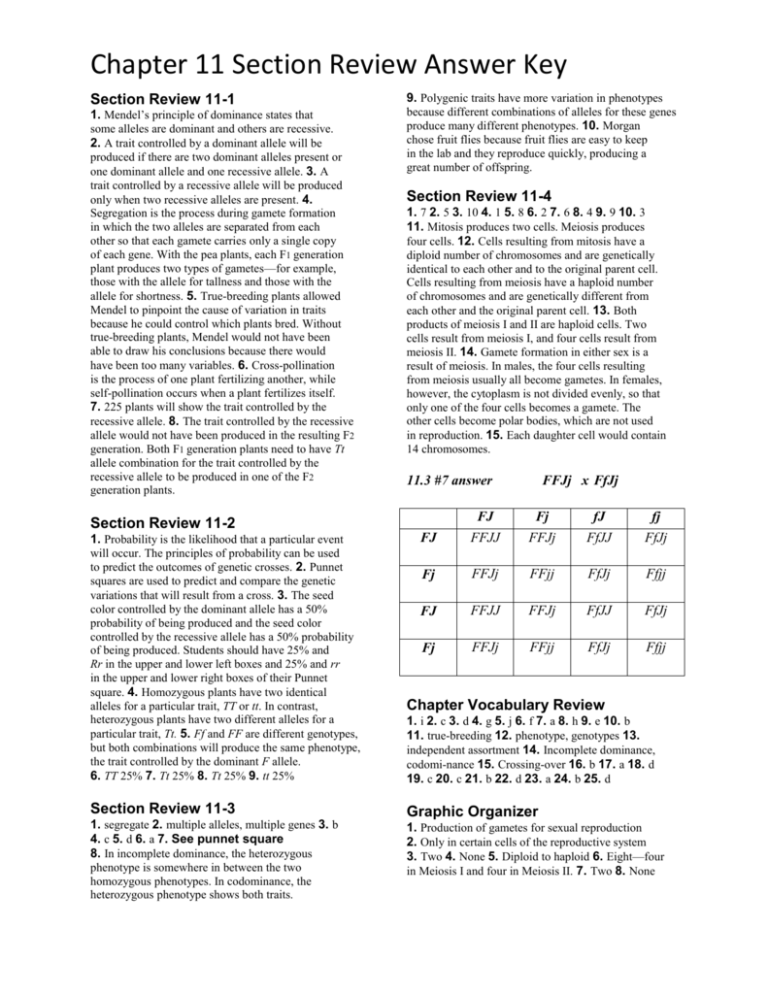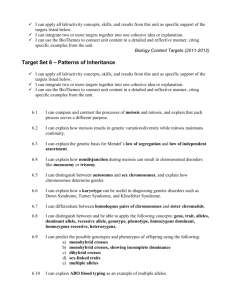Chapter 11 Genetics Review Answer Key
advertisement

Chapter 11 Section Review Answer Key Section Review 11-1 1. Mendel’s principle of dominance states that some alleles are dominant and others are recessive. 2. A trait controlled by a dominant allele will be produced if there are two dominant alleles present or one dominant allele and one recessive allele. 3. A trait controlled by a recessive allele will be produced only when two recessive alleles are present. 4. Segregation is the process during gamete formation in which the two alleles are separated from each other so that each gamete carries only a single copy of each gene. With the pea plants, each F1 generation plant produces two types of gametes—for example, those with the allele for tallness and those with the allele for shortness. 5. True-breeding plants allowed Mendel to pinpoint the cause of variation in traits because he could control which plants bred. Without true-breeding plants, Mendel would not have been able to draw his conclusions because there would have been too many variables. 6. Cross-pollination is the process of one plant fertilizing another, while self-pollination occurs when a plant fertilizes itself. 7. 225 plants will show the trait controlled by the recessive allele. 8. The trait controlled by the recessive allele would not have been produced in the resulting F2 generation. Both F1 generation plants need to have Tt allele combination for the trait controlled by the recessive allele to be produced in one of the F2 generation plants. 9. Polygenic traits have more variation in phenotypes because different combinations of alleles for these genes produce many different phenotypes. 10. Morgan chose fruit flies because fruit flies are easy to keep in the lab and they reproduce quickly, producing a great number of offspring. Section Review 11-4 1. 7 2. 5 3. 10 4. 1 5. 8 6. 2 7. 6 8. 4 9. 9 10. 3 11. Mitosis produces two cells. Meiosis produces four cells. 12. Cells resulting from mitosis have a diploid number of chromosomes and are genetically identical to each other and to the original parent cell. Cells resulting from meiosis have a haploid number of chromosomes and are genetically different from each other and the original parent cell. 13. Both products of meiosis I and II are haploid cells. Two cells result from meiosis I, and four cells result from meiosis II. 14. Gamete formation in either sex is a result of meiosis. In males, the four cells resulting from meiosis usually all become gametes. In females, however, the cytoplasm is not divided evenly, so that only one of the four cells becomes a gamete. The other cells become polar bodies, which are not used in reproduction. 15. Each daughter cell would contain 14 chromosomes. 11.3 #7 answer Introduction to G FJ FJ FFJJ Fj FFJj fJ FfJJ fj FfJj Fj FFJj FFjj FfJj Ffjj FJ FFJJ FFJj FfJJ FfJj Fj FFJj FFjj FfJj Ffjj Section Review 11-2 1. Probability is the likelihood that a particular event will occur. The principles of probability can be used to predict the outcomes of genetic crosses. 2. Punnet squares are used to predict and compare the genetic variations that will result from a cross. 3. The seed color controlled by the dominant allele has a 50% probability of being produced and the seed color controlled by the recessive allele has a 50% probability of being produced. Students should have 25% and Rr in the upper and lower left boxes and 25% and rr in the upper and lower right boxes of their Punnet square. 4. Homozygous plants have two identical alleles for a particular trait, TT or tt. In contrast, heterozygous plants have two different alleles for a particular trait, Tt. 5. Ff and FF are different genotypes, but both combinations will produce the same phenotype, the trait controlled by the dominant F allele. 6. TT 25% 7. Tt 25% 8. Tt 25% 9. tt 25% Section Review 11-3 1. segregate 2. multiple alleles, multiple genes 3. b 4. c 5. d 6. a 7. See punnet square 8. In incomplete dominance, the heterozygous phenotype is somewhere in between the two homozygous phenotypes. In codominance, the heterozygous phenotype shows both traits. FFJj x FfJj KEY Chapter Vocabulary Review 1. i 2. c 3. d 4. g 5. j 6. f 7. a 8. h 9. e 10. b 11. true-breeding 12. phenotype, genotypes 13. independent assortment 14. Incomplete dominance, codomi-nance 15. Crossing-over 16. b 17. a 18. d 19. c 20. c 21. b 22. d 23. a 24. b 25. d Graphic Organizer 1. Production of gametes for sexual reproduction 2. Only in certain cells of the reproductive system 3. Two 4. None 5. Diploid to haploid 6. Eight—four in Meiosis I and four in Meiosis II. 7. Two 8. None








